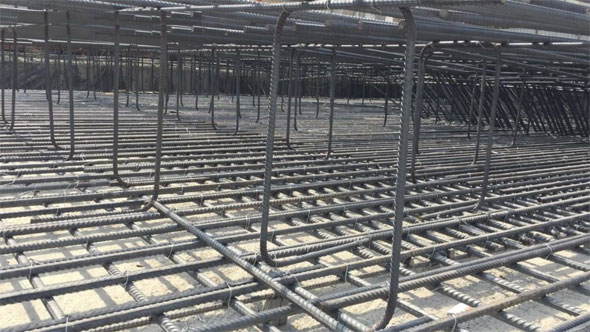Concrete Chairs Reinforcement Supports
- Concrete Cost Estimator
- Concrete Continuous Footing
- Landscape Bidding and Estimating
- Construction Cost Estimating
- Concrete and steel cost estimation
- Construction Cost Estimate Breakdown
- Construction Estimating Worksheet
- Home Construction Cost Estimate
- Estimate Pricing Sheet
- Sheet for General Contractor
- Construction Cost Estimate
- Labor Materials Cost Estimator
- Masonry Estimating Sheet
- Sheet for Building Contractor
- Construction Schedule Bar chart
- General Cost Estimator Sheet
- General Construction Estimate
- Building and Road Estimating Sheet
- Detailed expense estimates
- Door and Window Takeoff Sheet
- General Construction Cost Estimating Sheet

Rebar alias reinforcing bar should be enclosed in concrete to the exact depth (known as cover) to enhance the strength of the concrete structure when designed.
Rebar chairs and related supports belong to the standard devices which are utilized to prop up the rebar or detach it from the concrete form in order that the rebar is encircled by concrete to retain the certain cover.
While construction work is going on the job site, Rebar Spacer or steel chair is mostly found in raft or mat foundations. It is normally shaped as Z or inverted U type reinforcement to equally detach the top and bottom mesh reinforcement or to arrange adequate space among the meshes. While setting up the main mesh reinforcement throughout construction, steel chairs can retain the spacing uniformly and retain the mesh reinforcement in exact position before and after concreting.
Several types of chairs and other supports are found for various applications. The exact support for any project is based on various factors like the type of surface below the concrete, the type of concrete formwork, and the design specifications.
Standard Rebar Chairs: These types of chairs are extensively used to pick up the rebar off the ground. These are mostly utilized on foundation footings, concrete slabs, and other flatwork. The chairs are formed with metal or plastic or other non-corrosive material. They add strength to the structure. They are lightweight, inexpensive, and easily set up.
Also Read: Some useful guidance to place reinforcement in RCC staircase
Standard steel chairs are equipped with plastic feet to resist spot decay on the concrete surface. The stainless steel chairs are also available and they are non-corrosive and mainly utilized when plastic is not accepted into the concrete or when the weight is heavy for plastic chairs.
Spacer Wheels: Spacer wheels are mainly applied on columns, walls, beams, pre-cast formwork, and round formwork. These are formed with plastic and the wheels contain internal webbing, or framework to retain the rebar at the center of the wheel. Since the wheel is round, it can't overturn like chairs when the rebar is shifted. Spacer wheels are strong and light and make nominal surface contact, and they are accessible with various rebar sizes.
Multi-Level Rebar Chairs: Multi-level chairs are useful for mats or other configurations that entail multiple layers of steel. The multi-level chair is arranged at multiple heights, facilitating you to set up a bottom layer, an intermediate layer, and a top layer, keeping spacing among all of the rebar layers. These chairs generally come with good strength and maintain perfect concrete flow in among the spacers. This solution can save time and money since no support fabrication is required.
Tip or Round Cap Rebar Spacer: A tip or round cap spacer is suitable when rebar is set up vertically and needs bottom or top concrete cover. The cap is set up at the end of the rebar and contains a thin, elongated tip that supports the rebar and places it at an exact height. The tip is also created to facilitate better concrete flow to resist breakouts.
The rebar chairs are designed based on the following standard raft details:
Standard Raft Section
• Raft thickness: 2000mm
• Main Mesh Reinforcement:
• Bottom: T32-200mm both ways
• Top: T25-200mm both ways
Load Calculations - The load is measured on the basis of the weight of the rebar reinforcement in the raft as follow:
• T25: 0.0378 kN/m length
• T32: 0.0632 kN/m length
An extra 1.5kN/m2 live load should be taken into consideration for any construction loads.
The rebar weight is computed with the following formula :-

Here, D stands for diameter
To get more details on how to work out the weight of rebar, go through the following link. www.thestructuralworld.com

- Application of concrete calculator
- Roofing Calculator can streamline the roof estimating process
- House construction cost calculator
- Engineering column design excel spreadsheet
- Material Estimating Sheet with Excel
- Materials List and Cost Estimate Worksheet
- Concrete Slab Estimating Calculator Sheet
- Common types of foundations for buildings
- Online calculation of construction materials
- Estimating with Excel for the Small Contractor
- Concrete Beam Design Spreadsheet
- Virtual Construction Management app for construction
- Autodesk’s Project Skyscraper
- Reed Construction’s Reed Insight
- Manage your construction project documentation
- Costimator, the popular cost estimating software
- On Center Software for construction professionals
- Free Construction Estimating Software
- Plumbing Calc Pro
- Cost Estimate Worksheet
- HVAC Piping Quantity Takeoff Worksheet
- Construction Estimating Software Sheet
- Estimate Cost Templates
- Construction Punch List
- Construction cost estimating template consisting estimating basic
- Gantt Chart Template for Excel
- Download Civil Engineering Spreadsheets with Verification
- The Building Advisor Estimating and Budgeting Worksheet
- Spreadsheet for design of concrete bridge
- Construction Estimating Software Free








